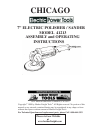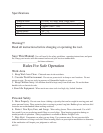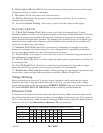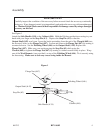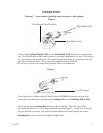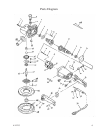
8. Guard Against Electric Shock. Prevent body contact with grounded surfaces such as pipes,
refrigerator enclosures, radiators, and ranges.
9. Disconnect Tools. Disconnect tools when not in use.
10. Do Not Overreach. Keep proper footing and balance at all times. Do not reach over
machines that are running.
11. Avoid Accidental Starting. Never carry a power tool with a finger on the trigger.
Tool Care And Use
12. Check For Damaged Parts. Before using a tool check for damaged parts. If found,
determine whether or not the tool will operate properly and perform its intended function. Check for
alignment of moving parts, binding of moving parts, breakage of moving parts, mounting, or any
other condition that might affect operation. Any damaged part should be serviced or replaced by an
authorized service center, unless otherwise stated elsewhere in this manual. Do not use the tool if
switch does not turn on and off properly.
13. Maintain Tools With Care Follow instructions for lubricating or changing accessories.
Inspect tool or charger cords before using. If a cord is damaged have it repaired by an authorized
service center. Keep handles dry, clean, and free from oil and grease.
14. Secure Work. Use clamps or a vise to hold your work. It is safer than using your hands and
frees both hands to operate the tool.
15. Do Not Force The Tool. It will do a better job and be safer to operate when used at the rate
it was designed for.
16. Use The Right Tool. Do not force a small tool or attachment to do the work of a larger,
heavy duty tool. Do not use the tool for a purpose for which it was not intended.
17. Replacement Parts And Accessories. When servicing use only identical replacement parts
or accessories. Approved parts and accessories are available at Harbor Freight Tools.
Voltage Warning
Before connecting any power tool to a power source (receptacle, outlet) make sure the voltage
supplied is the same as specified on the name plate on the tool. A power source with a voltage
greater than specified on the tool can result in SERIOUS INJURY to the user, and damage the tool.
If in doubt, DO NOT PLUG IN THE TOOL and ask a qualified, certified technician.
Extension Cords
An extension cord should not be used unless absolutely necessary. Make sure that the pins on the
plug of the extension cord are the same number, size and shape as those on the tool. If an extension
cord is to be used outdoors, make sure that it is designated W-A on the cord jacket. Round jacketed
extension cords listed by Underwriters Laboratory (UL) are preferable.
#41213 3
A
W
G
AMP RATING TOTAL EXTENSION CORD(S) LENGHT IN FEET
25 50 75 100 125 150 175 200
0-10.0 18 18 16 16 14 14 12 12
10.1-13.0 16 16 14 14 14 12 12 12
13.1-15 14 14 12 12 12 12 12 --
15.1-18 12 12 12 12 12 12 -- --
REV 06/05



